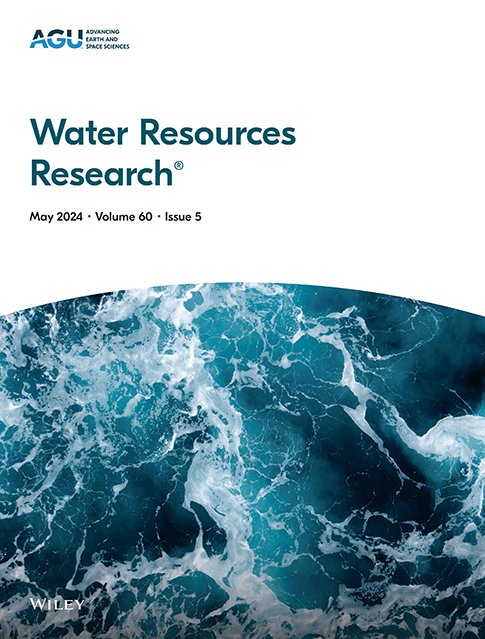复杂河流环境下改进的水位反演:中国河流Sentinel-3和Sentinel-6高度计
IF 4.6
1区 地球科学
Q2 ENVIRONMENTAL SCIENCES
引用次数: 0
摘要
自20世纪80年代以来,原位水位测量的下降阻碍了我们充分了解水文和水动力过程的能力,特别是在未测量的河流流域,以及全球和区域水循环如何响应气候变化。卫星测高提供了一种宝贵的手段,可以在时间和空间上补充河流水位数据中的这些空白。然而,现有的雷达波形跟踪技术往往难以适应不同形态和周围环境的河流。本文提出了一种基于50%阈值和Ice-1组合(TIC)算法的改进多子波形分析(IMSA)算法,在子波搜索模块中加入噪声滤波,改进了多子波的重跟踪策略,不依赖于粗数字高程模型(dem)。我们使用来自23个测量站的原位数据验证了IMSA算法,并将其应用于中国57个虚拟站点(VSs)的Sentinel-3和Sentinel-6高程,覆盖了宽度从20到1500米的河流,生成了79个验证结果(每个结果都代表了高程测量与原位测量的RMSE值)。与原始的TIC算法相比,IMSA算法在48 vs64以上的验证结果中表现出显著的增强,实现了最低的中位数RMSE为0.61 m(比OCOG、Threshold、MWaPP和TIC算法低0.13-0.50 m),对环境噪声具有较强的恢复能力。误差分析表明,高程精度主要受下垫面特征的影响,其中建成区对高程精度影响较大。额外的干扰来自周围的水域、大斜坡、与卫星地面轨道平行的河道,以及独特的特征,如沙洲、辫状和冰覆盖的河流和水电站。研究发现,合成孔径雷达(SAR)模式可以减轻这些影响,进一步提高水位反演精度。最后,研究结果表明,只要机载跟踪系统有准确的先验dem和最小的坡度干扰支持,河流宽度和地形(无论是山地还是平坦)不会固有地影响高程精度。本文章由计算机程序翻译,如有差异,请以英文原文为准。
Improved Water Level Retrieval in Complex Riverine Environments: Sentinel-3 and Sentinel-6 Altimetry Over China's Rivers
The decline in in situ water level measurements since the 1980s has impeded our ability to fully understand hydrological and hydrodynamic processes, particularly in ungauged river reaches, and how global and regional water cycles respond to climate change. Satellite altimetry offers a valuable means of supplementing these gaps in river water level data, both temporally and spatially. However, existing radar waveform retracking techniques often struggle to accommodate rivers with varying morphologies and surrounding environments. This study presents an Improved Multiple Subwaveform Analysis (IMSA) algorithm based on the 50% Threshold and Ice-1 Combined (TIC) algorithm, incorporating noise filtering into the subwave search module and refining the retracking strategy for multiple subwaves, independent of coarse digital elevation models (DEMs). We validated the IMSA algorithm using in situ data from 23 gauging stations and applied it to Sentinel-3 and Sentinel-6 altimetry across 57 virtual stations (VSs) in China, covering rivers with widths ranging from 20 to 1,500 m, generating 79 validation results (each representing an RMSE value comparing altimetry with in situ measurements). The IMSA algorithm demonstrated significant enhancements at over 48 VSs with more than 64 validation results compared to the original TIC, achieving the lowest median RMSE of 0.61 m (0.13–0.50 m lower than the OCOG, Threshold, MWaPP, and TIC algorithms), with strong resilience to environmental noise. Error analysis revealed that the altimetric accuracy is primarily influenced by the underlying surface characteristics of VSs, with built-up areas exerting significant interference. Additional disturbances stem from surrounding waters, large slopes, river channels running parallel to the satellite's ground track, and unique features such as sandbars, braided and ice-covered rivers, and hydroelectric stations. The synthetic aperture radar (SAR) mode was found to mitigate some of these land cover impacts, further improving water level retrieval accuracy. Finally, the results show that river width and topography (whether mountainous or flat) do not inherently affect altimetric accuracy, provided that the on-board tracking system is supported by accurate prior DEMs and minimal slope interference.
求助全文
通过发布文献求助,成功后即可免费获取论文全文。
去求助
来源期刊

Water Resources Research
环境科学-湖沼学
CiteScore
8.80
自引率
13.00%
发文量
599
审稿时长
3.5 months
期刊介绍:
Water Resources Research (WRR) is an interdisciplinary journal that focuses on hydrology and water resources. It publishes original research in the natural and social sciences of water. It emphasizes the role of water in the Earth system, including physical, chemical, biological, and ecological processes in water resources research and management, including social, policy, and public health implications. It encompasses observational, experimental, theoretical, analytical, numerical, and data-driven approaches that advance the science of water and its management. Submissions are evaluated for their novelty, accuracy, significance, and broader implications of the findings.
 求助内容:
求助内容: 应助结果提醒方式:
应助结果提醒方式:


